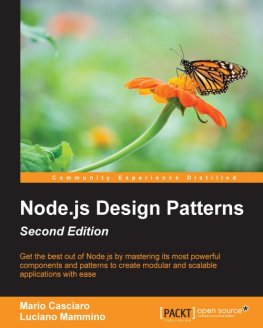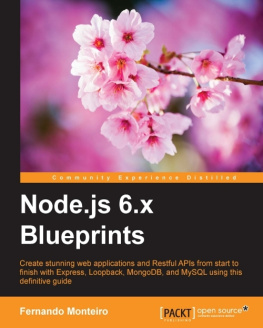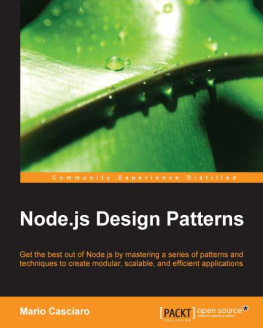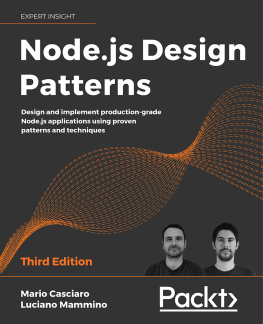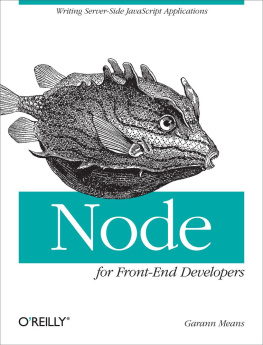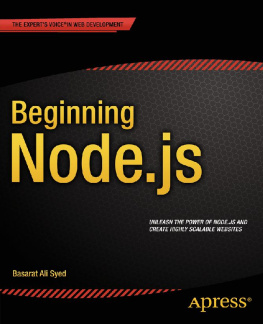Luciano Mammino - Node.js Design Patterns - Second Edition
Here you can read online Luciano Mammino - Node.js Design Patterns - Second Edition full text of the book (entire story) in english for free. Download pdf and epub, get meaning, cover and reviews about this ebook. year: 2016, publisher: Packt Publishing, genre: Computer. Description of the work, (preface) as well as reviews are available. Best literature library LitArk.com created for fans of good reading and offers a wide selection of genres:
Romance novel
Science fiction
Adventure
Detective
Science
History
Home and family
Prose
Art
Politics
Computer
Non-fiction
Religion
Business
Children
Humor
Choose a favorite category and find really read worthwhile books. Enjoy immersion in the world of imagination, feel the emotions of the characters or learn something new for yourself, make an fascinating discovery.
- Book:Node.js Design Patterns - Second Edition
- Author:
- Publisher:Packt Publishing
- Genre:
- Year:2016
- Rating:4 / 5
- Favourites:Add to favourites
- Your mark:
Node.js Design Patterns - Second Edition: summary, description and annotation
We offer to read an annotation, description, summary or preface (depends on what the author of the book "Node.js Design Patterns - Second Edition" wrote himself). If you haven't found the necessary information about the book — write in the comments, we will try to find it.
Get the best out of Node.js by mastering its most powerful components and patterns to create modular and scalable applications with ease
About This Book
- Create reusable patterns and modules by leveraging the new features of Node.js .
- Understand the asynchronous single thread design of node and grasp all its features and patterns to take advantage of various functions.
- This unique guide will help you get the most out of Node.js and its ecosystem.
Who This Book Is For
The book is meant for developers and software architects with a basic working knowledge of JavaScript who are interested in acquiring a deeper understanding of how to design and develop enterprise-level Node.js applications.
Basic knowledge of Node.js is also helpful to get the most out of this book.
What You Will Learn
- Design and implement a series of server-side JavaScript patterns so you understand why and when to apply them in different use case scenarios
- Become comfortable with writing asynchronous code by leveraging constructs such as callbacks, promises, generators and the async-await syntax
- Identify the most important concerns and apply unique tricks to achieve higher scalability and modularity in your Node.js application
- Untangle your modules by organizing and connecting them coherently
- Reuse well-known techniques to solve common design and coding issues
- Explore the latest trends in Universal JavaScript, learn how to write code that runs on both Node.js and the browser and leverage React and its ecosystem to implement universal applications
In Detail
Node.js is a massively popular software platform that lets you use JavaScript to easily create scalable server-side applications. It allows you to create efficient code, enabling a more sustainable way of writing software made of only one language across the full stack, along with extreme levels of reusability, pragmatism, simplicity, and collaboration. Node.js is revolutionizing the web and the way people and companies create their software.
In this book, we will take you on a journey across various ideas and components, and the challenges you would commonly encounter while designing and developing software using the Node.js platform. You will also discover the Node.js way of dealing with design and coding decisions.
The book kicks off by exploring the basics of Node.js describing its asynchronous single-threaded architecture and the main design patterns. It then shows you how to master the asynchronous control flow patterns,and the stream component and it culminates into a detailed list of Node.js implementations of the most common design patterns as well as some specific design patterns that are exclusive to the Node.js world.Lastly, it dives into more advanced concepts such as Universal Javascript, and scalability and its meant to conclude the journey by giving the reader all the necessary concepts to be able to build an enterprise grade application using Node.js.
Style and approach
This book takes its intended readers through a comprehensive explanation to create a scalable and efficient real-time server-side apps.
Downloading the example code for this book. You can download the example code files for all Packt books you have purchased from your account at http://www.PacktPub.com. If you purchased this book elsewhere, you can visit http://www.PacktPub.com/support and register to have the code file.
Luciano Mammino: author's other books
Who wrote Node.js Design Patterns - Second Edition? Find out the surname, the name of the author of the book and a list of all author's works by series.

